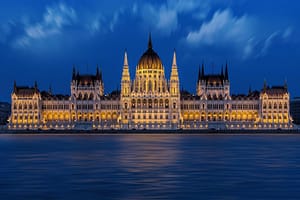The territory of Hungary has been inhabited for more than half a million years. The Romans occupied Transdanubia, the western part of Hungary, around the birth of Christ. Its name was Pannonia and its capital Acquincum. Hungary tribes first came to this part of Europe in 895-896, and managed the control of the whole Carpathian basin within a few years. Their original home was probably Asia. The Hungarian language is of Finno-Ugrian origin too. Stephen, the first king of Hungary organised the state and christianized the country. The members of his family ruled over Hungary for the next three centuries and built many churches in Romanesque style.
During the reign of the Árpád dynasty in the 13th century a new art, the so-called Gothic was born. The most important witness of the Gothic style is the Matthias church in Budapest, which was build in the 13th century, but was rebuilt and enlarged at the end of the last century in Neo-Gothic style. It was the place of coronation for several kings. In the green heart of Budapest, on Margaret Island you can see the ruins of a Gothic nunnery.
From the 13th till the middle of the 15th century Hungary was ruled by the Houses of Angevins and the Luxembourg’s. One of the most prominent figures in the Hungarian history, King Matthias got the throne in the 15th century. Fortresses and castles were established in this period.
Many fortresses have been enlarged against the Turkish invasion. In the middle of the 16th century Hungary was broken into three parts. The Turks took over Buda, the capital and occupied the central part of the country. The western and northern territories fell into the hands of Habsburg rulers, while the eastern part, Transsylvania became an independent principality. During the following 150 years the Turks left their culture to us including their famous baths.
Following the victorious campaign against the Turks the court of Vienna commenced a vigorous attack on the independence of Hungarian nobles. The country supported in the revolution of Prince Ferenc Rákóczi II. in 1703, which failed after eight years. His home was Sárospatak (Northern Hungary).
Hungary belonged to the Austrian Empire until the end of the first World War. During this period of Austrian rule some prominent Hungarian figures fought for the independence of the country, and they promoted our history, culture and language. At the end of World War I, defeated Hungary lost 71 percent of its territory as a result of the Treaty of Trianon (1920). Since then, grappling with the loss of more than two-thirds of their territory and people, Hungarians have looked to a past that was greater than the present as their collective psyche suffered from the so-called “Trianon Syndrome.” The syndrome was widespread prior to 1945; it was suppressed during Soviet domination (1945–90); and it reemerged during independence in 1990, when it took on a different form. The modern country appears to be split into two irreconcilable factions: those who are still concerned about Trianon and those who would like to forget it. This split is evident in most aspects of Hungarian political, social, and cultural life.
Today Hungary is wholly Budapest-centred. The capital dominates the country both by the size of its population—which dwarfs those of Hungary’s other cities—and by the concentration within its borders of most of the country’s scientific, scholarly, and artistic institutions.

